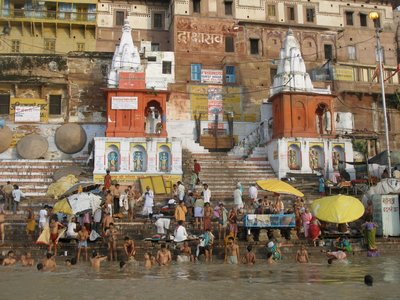Just when you think you've seen it all, you get to Varanasi
We left Agra on the night train, supposedly leaving at 9pm but as is common here, the train was late arriving and didnt pull into the station until 10.40! Also as is a daily occurance in India, there was a power cut at the station and so no electricity - luckily the trains are diesel - so we sat around in darkness, with hundreds of Indians, a handfull of backpackers and loads of dogs and rats.
We were told the journey was 7 hours, but 11 hours later we pulled into Varanasi station and went to the hotel we had picked from our Lonely Planet travel bible. The streets were more chaotic and dirty than we have seen so far, and we thought that what we had experienced was extreme. People are everywhere and thousands of rickshaws, motorickshaws, mopeds/vespas, bicycles and people on foot all share the same dirt, concrete or tarmac(asfalto) piece of road. Of course not forgetting the fle-ridden (llenos de moscas y pulgas) cows and buffallo, dogs and goats which also walk around freely and search amongst the tons of rubbish on either side of the road.
Varanasi is one of the holiest cities in India, Hindu pilgrims come to was away their sins in the Ganges river, and many come here to die and to be burnt by the side of the ganges, and their ashes then thrown in it.
We were told the journey was 7 hours, but 11 hours later we pulled into Varanasi station and went to the hotel we had picked from our Lonely Planet travel bible. The streets were more chaotic and dirty than we have seen so far, and we thought that what we had experienced was extreme. People are everywhere and thousands of rickshaws, motorickshaws, mopeds/vespas, bicycles and people on foot all share the same dirt, concrete or tarmac(asfalto) piece of road. Of course not forgetting the fle-ridden (llenos de moscas y pulgas) cows and buffallo, dogs and goats which also walk around freely and search amongst the tons of rubbish on either side of the road.
Varanasi is one of the holiest cities in India, Hindu pilgrims come to was away their sins in the Ganges river, and many come here to die and to be burnt by the side of the ganges, and their ashes then thrown in it.

people bathing in the Ganges
Varanasi's principle attraction is the the log string of ghats (about 80) that line the western bank of the Ganges. Most are used for bathing but there are also several 'burning ghats' where bodies wrapped in cloth are cremated in public. Photos are not allowed (but we managed to take a couple from a distance as the photo on the right shows) but we actually sat and saw the ceremony in front of us. Neither of us will forget the smell of burning bodies or the sight of legs and half-burnt heads, or a dog trying to take part of a body from one of the unguarded fires (there are about 10 cremations at the same time, all in different stages).
Photos are not allowed (but we managed to take a couple from a distance as the photo on the right shows) but we actually sat and saw the ceremony in front of us. Neither of us will forget the smell of burning bodies or the sight of legs and half-burnt heads, or a dog trying to take part of a body from one of the unguarded fires (there are about 10 cremations at the same time, all in different stages).The back streets of Varansi are a world to their own, a sub-world within the heart of the city where Muslims and Hindus go about their daily life. We often saw old people just lying there in doorways, very frail (fragil) and almost lifeless people, perhaps just waiting for their time to come. We had a sort of fear of what we might see around the next corner, but in the end we knew that is would be the same as the previous street: cows, goats, dogs, animal faeces, rubbish, dirt and poverty at its most harsh (duro).

0 Comments:
Post a Comment
<< Home